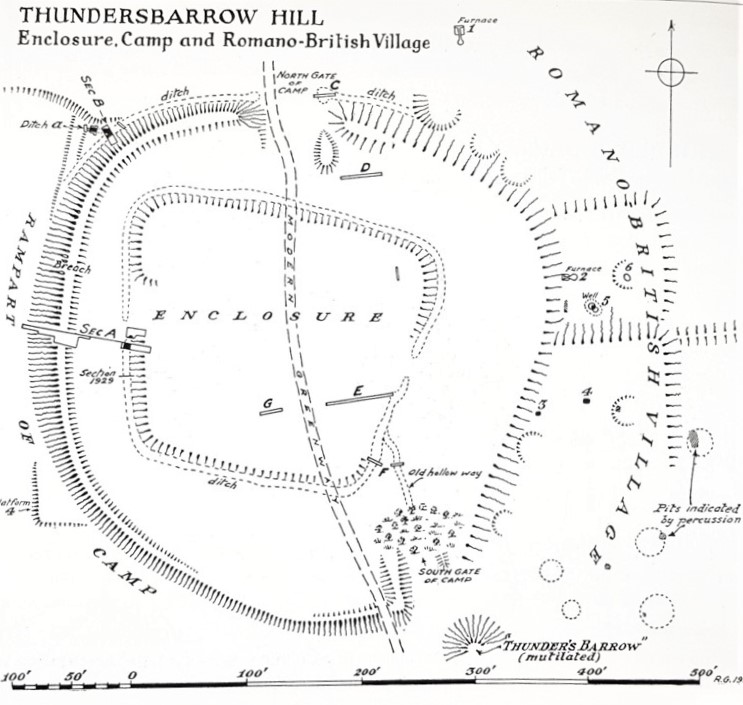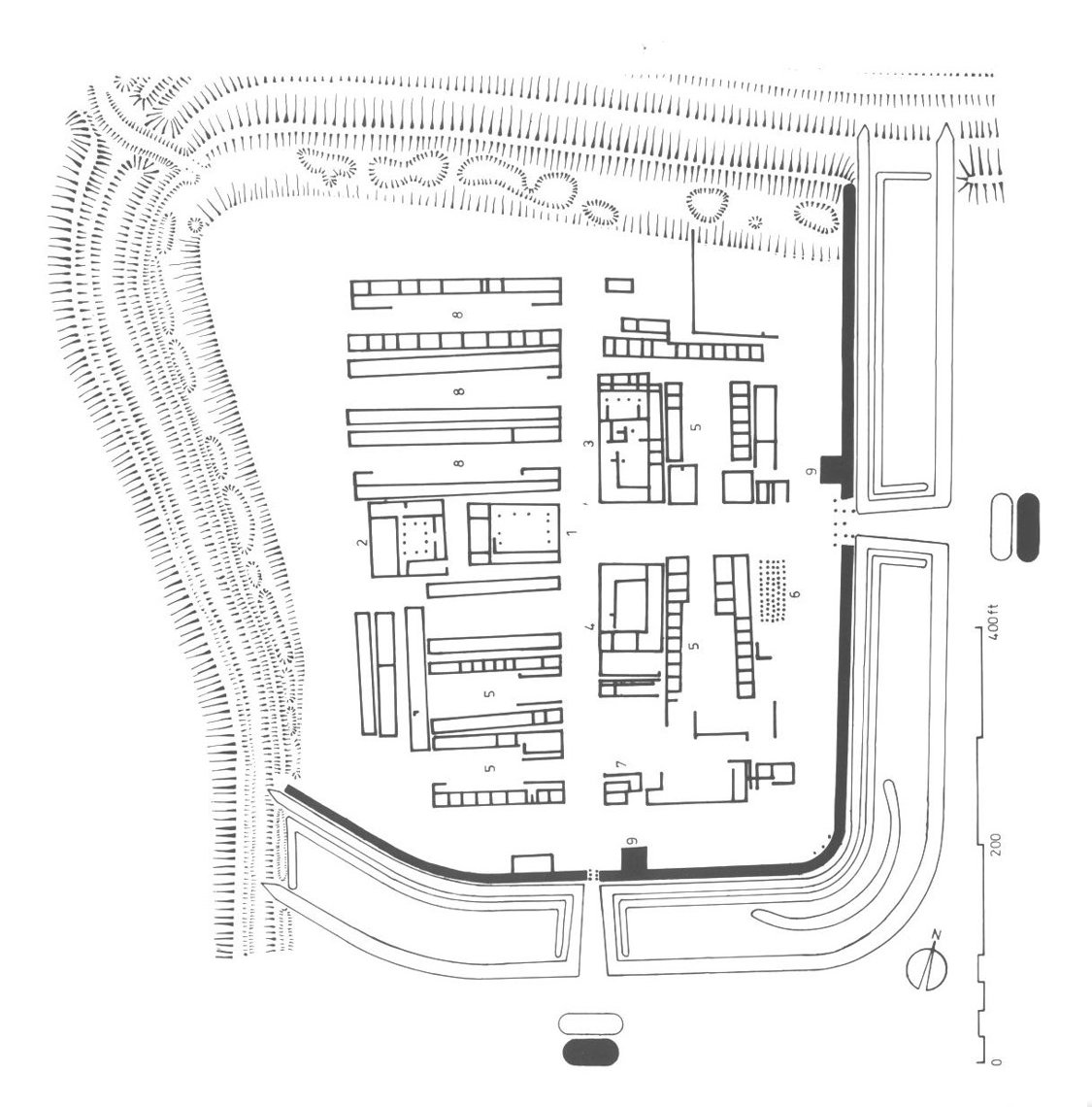It's #HillfortsWednesday and here’s the curiously enigmatic (and infrequently examined) prehistoric earthwork enclosures atop the wonderfully named Thundersbarrow Hill #WestSussex @sdnpa 😍
Pic © CACUP 1975 (BSR60) @CamDigLib @theUL
A short thread 👇👇👇
Pic © CACUP 1975 (BSR60) @CamDigLib @theUL
A short thread 👇👇👇

The subcircular Iron Age hillfort of Thundersbarrow covers 1.2ha with entrances at the SE and N
It encloses a 0.5ha subsquare Bronze Age enclosure with a barrow and Romano British village at the S + E
Plan: Robert Gurd 1932 © Sussex Arch Soc @sussex_society
#HillfortsWednesday
It encloses a 0.5ha subsquare Bronze Age enclosure with a barrow and Romano British village at the S + E
Plan: Robert Gurd 1932 © Sussex Arch Soc @sussex_society
#HillfortsWednesday

Thundersbarrow Early Iron Age hillfort sits brooding atop a low ridge at the southern slope of the chalk downs @sdnpa above the Sussex coastal plain and Shoreham-by-Sea
It's easy to spot once you know it's there
Pic Simon Carey 2005 CC BY-SA 2.0
#HillfortsWednesday
It's easy to spot once you know it's there
Pic Simon Carey 2005 CC BY-SA 2.0
#HillfortsWednesday

The landscape context of Thundersbarrow hillfort and its relationship to prehistoric, Romano British and later fieldsystems is evident in these contour and relief LiDAR maps looking SE generated by @planlaufterrain @HenryRothwell
See digitaldigging.net/thundersbarrow…
#HillfortsWednesday

See digitaldigging.net/thundersbarrow…
#HillfortsWednesday


The archaeology of Thundersbarrow Hill (a BA barrow, LBA enclosure, EIA hillfort and a RB village with field systems) was recorded in meticulous detail from 1916-32 by Robert Gurd, William Jacobs, Herbert Toms and EC Curwen, prior to plough damage 🤩
#HillfortsWednesday
#HillfortsWednesday

The hillfort of Thundersbarrow has been levelled by ploughing at the E, but survives as a low earthwork along the W as evident in this aerial pic looking NE
The inner Bronze Age enclosure appears as a crop mark
Pic © CACUP 1975 (BSR58) @CamDigLib @theUL
#HillfortsWednesday
The inner Bronze Age enclosure appears as a crop mark
Pic © CACUP 1975 (BSR58) @CamDigLib @theUL
#HillfortsWednesday

The western edge of Thundersbarrow hillfort #WestSussex, despite agricultural attrition, can just be made out today, the rampart surviving to just under 1m in height above a shallow 6m wide ditch
Pics Robin Webster / A R Cane CC BY-SA 4.0
#HillfortsWednesday

Pics Robin Webster / A R Cane CC BY-SA 4.0
#HillfortsWednesday


Excavations at Thundersbarrow by Elliot Cecil Curwen in 1932 sampled the Iron Age hillfort, Bronze Age enclosure and Romano British grain-drying / malting ovens identified through ground percussion
Robert Gurd was on hand to record them © @sussex_society
#HillfortsWednesday
Robert Gurd was on hand to record them © @sussex_society
#HillfortsWednesday

In August 1985, excavations at Thundersbarrow hillfort #WestSussex were conducted by David Rudling on behalf of the Sussex Archaeological Field Unit @UCLarchaeology
It was fun (if cold) 👍
#HillfortsWednesday (early #ThrowbackThursday)


It was fun (if cold) 👍
#HillfortsWednesday (early #ThrowbackThursday)



Excavations at Thundersbarrow Hill #WestSussex @UCLarchaeology August 1985 for #HillfortsWednesday and #ThrowbackThursday
As with all digs in the 80s, on-site facilities were a tad basic 😊
a) photographic tower 😱
b) accommodation 😱😱
c) something best not mentioned😱😱😱


As with all digs in the 80s, on-site facilities were a tad basic 😊
a) photographic tower 😱
b) accommodation 😱😱
c) something best not mentioned😱😱😱



Excavations in August 1985 across the barrow of ‘Thundersbarrow’ Hill #WestSussex confirmed it was indeed of Early Bronze Age date
#HillfortsWednesday
#HillfortsWednesday

The 1985 excavation by David Rudling #SAFU @ArchSouthEast @UCLarchaeology across the inner enclosure at Thundersbarrow Hill confirmed this earlier phase dated to the Later Bronze Age (10th / 9th century BC)
The outer ditch was 3m wide and 0.6m deep
#HillfortsWednesday
The outer ditch was 3m wide and 0.6m deep
#HillfortsWednesday

Excavation by #SAFU (now @ArchSouthEast @UCLarchaeology) across the bank and outer ditch of Thundersbarrow Hill #WestSussex in 1985 recovered finds that suggesting the hillfort was constructed in the 6th c BC and went out of use in the mid-3rd c BC
Happy #HillfortsWednesday !


Happy #HillfortsWednesday !



• • •
Missing some Tweet in this thread? You can try to
force a refresh





























